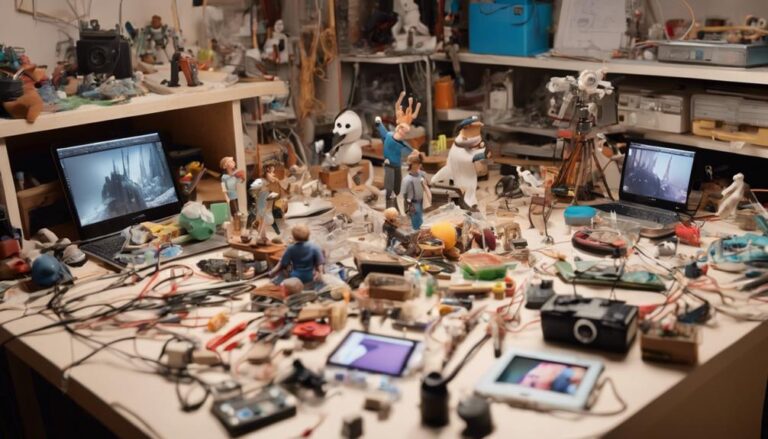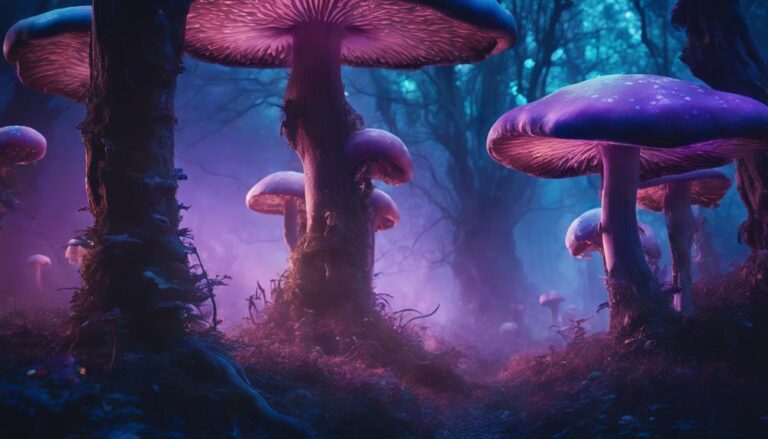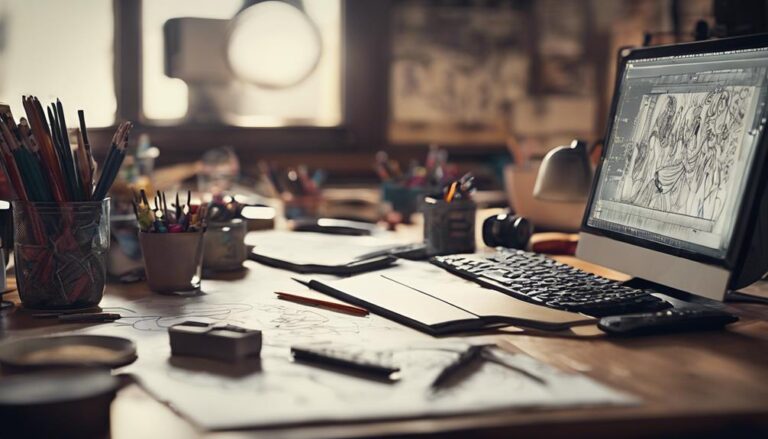Types of 2D Animation Techniques Used
You're about to discover a vast array of 2D animation techniques that have captivated audiences for decades. Traditional hand-drawn animation meticulously crafts each frame, while digital cut-out animation offers flexibility and control. Stop-motion techniques breathe life into inanimate objects, and limited animation methods streamline the process. Rotoscope animation combines live-action footage with drawing, and vector-based styles create stylized characters. Flash animation brings vectors to life, pixilation manipulates real-world objects, and multiplane camera techniques simulate dynamic movements. From classic to cutting-edge, each technique offers a unique visual fingerprint – and that's just the beginning of your journey into the world of 2D animation.
Key Takeaways
- Traditional Hand-Drawn Animation involves labor-intensive processes like pencil testing, inking, and painting to create a unique work of art.
- Digital Cut-Out Animation allows for complete control and flexibility over the animation process, making it efficient and scalable.
- Vector-Based Animation Style creates stylized characters and environments with geometric precision, retaining clarity regardless of resolution or scale.
- Flash Animation Techniques involve manipulating vectors, tweening frames, and adding motion to create engaging, interactive experiences.
- Limited Animation Methods streamline the animation process, focusing on key poses and movements to convey complex ideas and emotions efficiently.
Traditional Hand-Drawn Animation
As you plunge into the world of traditional hand-drawn animation, you'll discover a labor-intensive process where each frame is meticulously crafted by hand, bringing characters to life with a unique blend of creativity and precision.
Every movement, every gesture, and every expression is carefully planned and executed to create a sense of fluidity and realism.
The process begins with pencil testing, where rough sketches are created to visualize the sequence of events and refine the timing.
This is followed by the inking process, where the pencil drawings are meticulously traced over with a pen or brush, adding depth and definition to the characters.
The inked drawings are then painted with vibrant colors, adding texture and emotion to the scene.
As you work through each frame, you'll notice the subtle nuances that bring the animation to life, from the way the light catches a character's hair to the subtle movement of their eyes.
With traditional hand-drawn animation, you're not just creating a scene – you're crafting a work of art.
Digital Cut-Out Animation
You step into the world of digital cut-out animation, where pre-designed characters and props are manipulated within a digital environment to create the illusion of movement and life. This technique has revolutionized the animation industry, offering a more efficient and cost-effective approach to traditional hand-drawn animation.
| Asset Creation | Digital Workflow | Final Product |
|---|---|---|
| Design and create characters and props | Import assets into animation software | Animated scenes with movement and life |
| Rig characters for movement and expression | Set up scenes and animation timelines | Colorful and engaging visuals |
| Create backgrounds and environments | Add special effects and sound design | Polished and professional animation |
In digital cut-out animation, you have complete control over every aspect of the animation process. You can easily make changes to character designs, adjust animation timing, and experiment with different visual styles. This flexibility, combined with the efficiency of a digital workflow, allows for rapid asset creation and a faster production timeline. With digital cut-out animation, you can bring your creative vision to life in a way that's both visually stunning and cost-effective.
Stop-Motion Animation Techniques
In the domain of stop-motion animation, three-dimensional characters and objects come to life under your skilled hands, their movements painstakingly crafted frame by frame to create a mesmerizing dance of texture, color, and light.
As you work, you'll employ model manipulation techniques to breathe life into inanimate objects. You'll carefully pose, re-pose, and adjust each character or prop to capture the subtleties of movement and expression.
Puppetry techniques are also essential in stop-motion animation. You'll use these skills to create the illusion of life, making your characters' movements appear natural and fluid.
By mastering the art of subtle gestures and nuanced expressions, you'll bring your creations to life in a way that enthralls audiences.
As you work, you'll need to ponder lighting, camera angles, and composition to create a cohesive visual narrative.
With each frame carefully crafted, you'll weave together a world of wonder and magic.
Stop-motion animation requires patience, attention to detail, and a deep understanding of the intricacies of movement and storytelling. But with practice and dedication, you'll decipher the secrets of this enchanting art form.
Limited Animation Methods
By streamlining your animation process, limited animation methods allow you to focus on key poses and movements, sacrificing some fluidity for efficiency and speed.
This approach is ideal for projects with limited budgeting, as it enables you to create engaging animations without breaking the bank. By prioritizing essential elements, you'll be able to allocate resources more effectively, ensuring your message is conveyed efficiently.
In limited animation, you'll typically use a reduced number of drawings or frames, relying on clever timing and camera movements to create the illusion of motion.
This technique requires a deep understanding of storytelling and pacing, as you'll need to carefully choreograph each scene to maximize impact. When done correctly, limited animation can be incredibly effective, allowing you to convey complex ideas and emotions through clever visual storytelling.
Rotoscope Animation Process
As you explore the Rotoscope Animation Process, you'll discover a technique that brings realism to your animations by drawing over actual footage.
By tracing real-life movement frame by frame, you'll capture the subtleties of human motion and create a more authentic look.
Now, let's break down this process further, refining your skills frame by frame to achieve stunning results.
Drawing Over Footage
You capture live-action footage, whether it's a person, animal, or object, and then meticulously draw over each frame to create the illusion of movement in the Rotoscope animation process. This technique allows for a seamless blend of live-action and animation, providing a unique visual aesthetic. By tracing over each frame, you can add colors, textures, and details that enhance the overall look and feel of the animation.
| Aspect | Description |
|---|---|
| Film Integration | Combines live-action footage with animation, creating a hybrid visual style |
| Live Action | Captures real-world movements and actions, adding realism to the animation |
| Artistic Freedom | Allows artists to manipulate and enhance the footage, creating a stylized look |
In Rotoscope animation, the drawn elements can be used to augment or even replace the original footage, giving you complete control over the final product. This technique is particularly useful when you want to achieve a realistic yet stylized look, or when you need to integrate live-action elements into an animated sequence. By drawing over footage, you can create an engrossing and immersive animation that engages your audience.
Tracing Real-Life Movement
With each frame meticulously captured, the Rotoscope animation process begins as you meticulously trace the real-life movement of your subject, meticulously recreating the subtle nuances and details that bring the animation to life.
As you plunge into the world of Rotoscope animation, you'll find yourself deeply invested in human observation, closely studying the way your subject moves, twitches, and reacts. Every gesture, every flicker of emotion, becomes vital in conveying authenticity.
You'll employ motion capture techniques to record your subject's movements, using cameras and sensors to translate their actions into digital data.
This data will serve as the foundation for your animation, allowing you to accurately recreate the subtleties of human movement. As you work through each frame, you'll refine your technique, honing in on the smallest details to create a seamless blend of reality and animation.
The result is an engrossing, lifelike animation that draws the viewer in, suspending disbelief and transporting them to a world of wonder.
Frame-by-Frame Refining
How do you breathe life into each frame, meticulously refining the subtleties of movement, posture, and expression to create a mesmerizing Rotoscope animation that pulsates with realism?
You do it through frame-by-frame refining, a pivotal step in the Rotoscope animation process. This is where you fine-tune every detail, ensuring that each frame builds upon the last to create a seamless, fluid motion.
As you refine each frame, you're not just tweaking minor adjustments; you're crafting a narrative that unfolds with every subtle movement.
You're perfecting the character's gait, the flutter of their eyelashes, and the curve of their smile.
It's a painstaking process, but the payoff is worth it.
With each refining process, you're injecting life into your animation, making it more relatable, more engaging, and more believable.
Computer-Generated Imagery
Computer-generated imagery (CGI) bursts onto the animation scene, revolutionizing the way artists bring fantastical worlds and characters to life.
With CGI, you can create intricate 3D models using specialized software, allowing for unparalleled precision and control.
By leveraging 3D modeling software, you can sculpt and refine every detail of your characters and environments, from the subtle curves of a facial expression to the ornate architecture of a fictional cityscape.
But what truly sets CGI apart is its ability to simulate realistic textures and materials.
Through the use of advanced texture mapping algorithms, you can imbue your creations with a sense of depth and authenticity, making them feel almost tangible.
From the rough, weathered bark of an ancient tree to the smooth, metallic sheen of a futuristic spacecraft, CGI allows you to craft an entire world of sights and textures that transport your audience to new and wondrous domains.
With CGI, the boundaries of imagination are pushed to new extremes, and the possibilities are endless.
Vector-Based Animation Style
As you plunge into the domain of vector-based animation, you'll discover a world of crisp, scalable graphics that burst with vibrant colors and geometric precision, allowing you to craft stylized characters and environments that pop with visual appeal.
This style is renowned for its ability to retain clarity and definition, regardless of resolution or scale.
Vector pioneers have long exploited this advantage, creating mesmerizing visuals that captivate audiences worldwide.
With vector-based animation, you can experiment with intricate shapes, bold lines, and striking textures, all while maintaining a clean, polished aesthetic.
Scalable graphics guarantee that your artwork remains crisp and detailed, whether viewed on a smartphone or a cinema screen.
This versatility has made vector-based animation a staple in various industries, from advertising and gaming to film and television.
Flash Animation Techniques
Flash animation techniques offer a powerful means to bring your vector creations to life, leveraging the software's robust toolkit to craft engaging, interactive experiences that resonate with audiences.
With a rich Flash history dating back to the 1990s, this software has evolved to become an industry standard for 2D animation.
Flash software provides a user-friendly interface, allowing you to create complex animations with ease. You can manipulate vectors, tween frames, and add motion to your designs, creating a sense of dynamism and energy.
Additionally, Flash's built-in timeline feature enables you to control the pacing and flow of your animation, ensuring a seamless viewing experience.
Pixilation Animation Method
Pixilation, a stop-motion technique that manipulates real-world objects and people, breathes life into everyday items by fragmenting their movements into a staccato sequence of poses. You'll often see pixilation used in music videos, commercials, and short films to create a unique, stylized look. By breaking down human interaction into individual frames, pixilation creates a sense of disjointedness, drawing attention to the smallest details of movement.
| Aspect | Pixilation | Traditional Animation |
|---|---|---|
| Medium | Real-world objects/people | Drawings/CGI |
| Movement | Fragmented, staccato | Smooth, fluid |
| Style | Stylized, realistic | Exaggerated, fantastical |
| Use Cases | Music videos, commercials | Feature films, TV shows |
As you experiment with pixilation, you'll find that it lends itself particularly well to live performances, where the manipulation of real-world objects can create a sense of wonder and surprise. By embracing the quirks and limitations of pixilation, you can create animations that are both visually striking and deeply engaging.
Multiplane Camera Animation
As you explore the world of Multiplane Camera Animation, you'll discover the power of camera movement techniques that transport your audience through immersive scenes.
By mastering layered image composition, you'll learn to create visually striking backgrounds that come alive with each frame.
Camera Movement Techniques
By layering artwork on multiple planes of glass, the multiplane camera technique simulates dynamic camera movements, creating the illusion of depth and immersion in 2D animations.
As you work with this technique, you'll find that it's particularly effective for capturing panoramic shots that sweep across vast landscapes or bustling cityscapes.
The multiplane camera allows you to create a sense of movement and energy, drawing the viewer's eye across the scene.
Dynamic framing is another key aspect of the multiplane camera technique.
By moving the camera closer to or further from specific elements, you can create a sense of tension or intimacy.
This can be especially useful when emphasizing key story beats or character moments.
As you experiment with the multiplane camera, you'll discover how it can add a level of sophistication and nuance to your animation.
Layered Image Composition
You'll build layered image compositions by stacking multiple elements, from background landscapes to foreground characters, each on its own plane of glass, allowing for subtle movements and interactions that breathe life into your 2D animation. This multiplane camera animation technique enables you to create rich, dynamic scenes that engage your audience.
Enhanced visual storytelling: By separating elements into individual planes, you can control the movement and interaction of each component, creating a more immersive experience for your viewers.
Increased depth and dimensionality: Layering elements creates a sense of layering, adding depth and dimensionality to your animation.
Improved image manipulation: With each element on its own plane, you can easily manipulate and adjust individual components without affecting the entire scene.
Greater creative control: Layered image composition gives you the flexibility to experiment with different movements, speeds, and interactions, allowing you to bring your vision to life.
Depth Perception Illusion
To create a convincing depth perception illusion, the multiplane camera animation technique cleverly manipulates the viewer's perception by layering multiple elements at varying distances from the camera, generating a sense of depth and dimensionality.
As you watch, the animation unfolds like a layered tapestry, with foreground, mid-ground, and background elements moving independently. This visual trickery creates an immersive experience, drawing you into the world of the animation.
Atmospheric cues, such as mist, fog, or haze, are often used to enhance the sense of depth, adding to the illusion.
By skillfully controlling the placement and movement of these elements, animators can create a convincing 3D environment within a 2D medium.
The result is a visually stunning and engaging animation that seems to leap off the screen.
With the multiplane camera technique, you're not just watching an animation – you're stepping into a richly textured world that surrounds you.
Frequently Asked Questions
What Software Is Commonly Used for 2D Digital Animation?
You'll likely find yourself working with Adobe Animate, leveraging its robust features for vector graphics and tweening, or OpenToonz, harnessing its advanced capabilities for traditional animation and cut-out rigs, to bring your 2D digital animation to life.
Can 2D Animation Be Used in Video Games?
You can bring 2D animation to life in video games, where it enhances game development by adding engaging cutscenes, interactive storytelling, and immersive experiences that draw players into the virtual world.
Is 2D Animation Still Used in Modern Films?
You might think 2D animation is a relic of the past, but it's still widely used in modern films, tapping into film nostalgia while maintaining industry relevance through its unique, handcrafted aesthetic and timeless storytelling appeal.
How Long Does It Take to Create a 2D Animated Short?
You'll spend around 3-6 months creating a 2D animated short, depending on complexity and team size. Establishing style consistency early on will save you time and headaches during production timelines, ensuring a cohesive final product.
Can I Learn 2D Animation Techniques on My Own?
You can master 2D animation techniques on your own by employing self-learning strategies, such as creating personalized tutorials, setting realistic goals, and dedicating time to practice, allowing you to develop your skills at your own pace.
Conclusion
As you explore into the world of 2D animation, you've now grasped the diverse range of techniques that bring imagination to life.
From traditional hand-drawn masterpieces to digital cut-out wonders, each style offers a unique visual language.
Stop-motion's tactile charm, limited animation's efficiency, rotoscope's realism, and vector-based animation's sleekness – the options are endless.
With flash, pixilation, and multiplane camera techniques, the possibilities are boundless.
Now, unshackle your creativity and let your artistic vision take flight!






